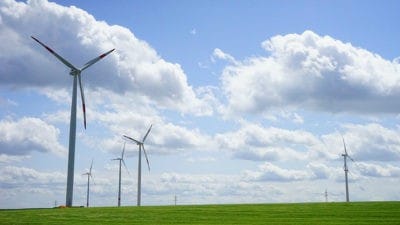For more than two years, Northland Power (TSX:NPI) stock has been range bound. Since 2016, the stock has traded at roughly $20-25 per share. It could be a compressed coil waiting to spring into action — once it breaks above the upper end of the sideways channel, it could be poised for a super run.
About Northland Power
Northland Power’s roots go as far back as 32 years ago, but it only began trading publicly in 1997. It develops, owns, and operates clean-energy facilities, including ones that are powered by natural gas, wind, solar, and hydro.
Northland Power has a net generating capacity of about 2,000 MW. It has about 40% in thermal generation, 30% and 10%, respectively, in offshore and onshore wind generation, and 5% in solar. It has a growing presence in Canada, the United States, Mexico, Latin America, Europe, and Taiwan.

A fast-growing company
For the past three years, Northland Power’s revenue increased at a compound annual growth rate (CAGR) of nearly 22%, while its operating cash flow increased at a CAGR of more than 32%. And it doesn’t look like it’s slowing down.
It has been growing globally and partnering up where appropriate. In 2017, it had offshore wind projects that went into service. They had net generating capacity of 360 MW and 280 MW, respectively, and Northland Power has 60% and 85% economic interests in the facilities.
The utility has projects that are in advanced stages of development or are under construction. First, the Deutsche Bucht offshore wind project in the North Sea will have 269 MW of generating capacity. This is a near-term growth project that’s expected to be commercially operational next year.
Second, the Hai Long projects in Taiwan are set to have a generating capacity of 1,044 MW; Northland Power has a 60% equity interest in Hai Long. These projects are long-term investments that are planned to come into service in 2026.
Investor takeaway
Northland Power has a market cap of $4.5 billion and an enterprise value of about $12.2 billion. Its capital spending has been huge ($6.2 billion) in the past few years, but it only generated $2.3 billion of operating cash flow in the period and fairly recently started generating free cash flow. In the last four reported quarters, its free cash flow generation was about $465 million. So, it largely financed its fast growth via cheap debt.
The utility’s recent debt/cap and debt/equity were 82% and 8.75, respectively. So, it’d be nice to see the company deleverage the balance sheet.
The strong insider ownership of about 34% is positive, as well as Northland Power’s commitment to the dividend, which it has maintained or increased since 2012. At about $25 per share, it offers a yield of nearly 4.8%.






